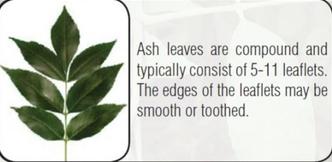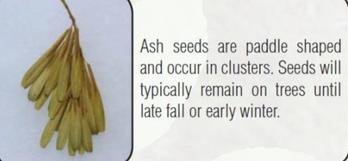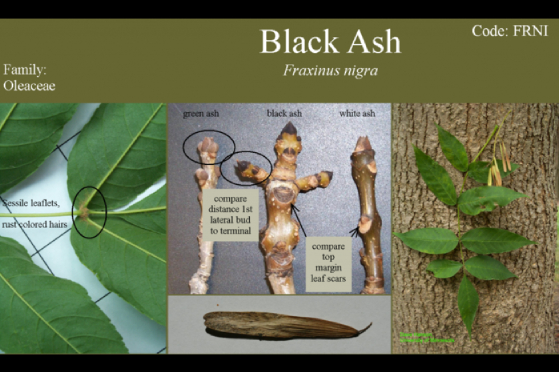How to Identify an Ash Tree
Tree Bark Identification
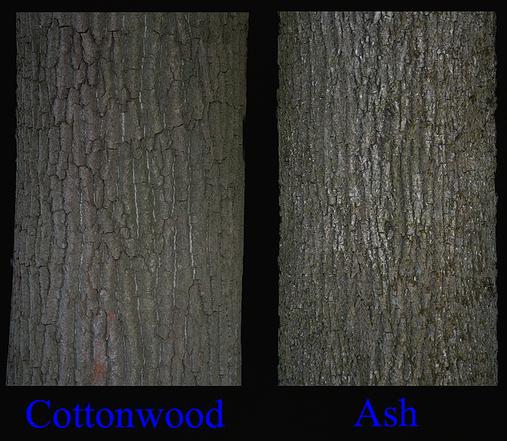
What types of trees do the emerald ash borer attack?
In North America, it is only found in ash trees—green, white, black, blue, pumpkin, Marshall seedless, Autumn Purple, and Summit are examples of susceptible species and cultivars. Ash trees in any setting (forest, landscape, woodlots, or fencerows) have been affected in infested areas. Branches as small as 1-inch diameter to trunks exceeding 2 feet in diameter have been colonized by this beetle.
What happens to infested ash trees?
Tunnels excavated by feeding larvae destroy the water and nutrient-conducting tissues under the bark; this effectively starves the ash tree. The canopy of heavily infested trees will begin to die, usually near the top and progressing downward. Sometimes, infested ash trees produce epicormic (“water”) sprouts on the trunk or branches below emerald ash borer activity. Adult feeding (removal of tissue along leaflet edges) can be seen on affected ash trees. The bark may crack directly over larval galleries. Adult beetles chew characteristic “D”-shaped exit holes as they leave former feeding sites below the bark. Woodpeckers often are found on infested ash tree trunks, feeding on larvae; this is most often noted during winter. Trees attacked by the emerald ash borer die within 1-3 years.

Firewood Quarantine
Moving firewood and other ash wood materials in areas infested with emerald ash borer are regulated by the infested states and federal government.
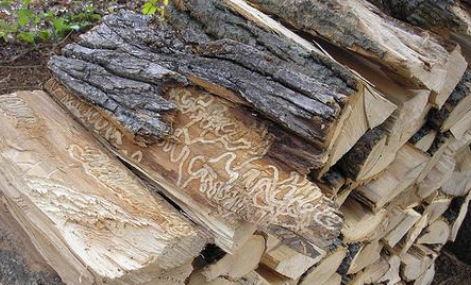
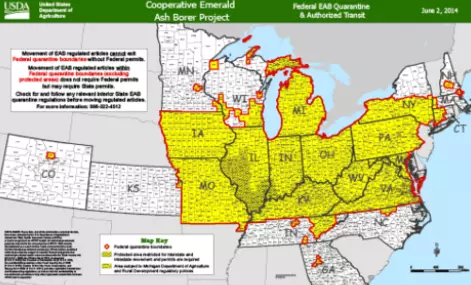
Emerald Ash Borer
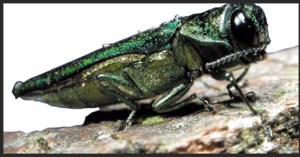
What is an emerald ash borer?
Emerald ash borer is an invasive beetle that belongs to the metallic wood-borer family. It infests and destroys all species of North American ash trees.

How does the emerald ash borer affect the tree?
Emerald ash borer beetles kill the tree by starving it of nutrients and water. Once the female lays her eggs on the bark of an ash tree, they pupate and become larvae. The larvae tunnel under the bark and disrupt the tree's vascular system by chewing on soft tissue that transports water and nutrients throughout the tree. After a couple of years, the emerald ash borer population grows exponentially inside the tree, and the combined damage will eventually kill it.
How can I tell if my tree is already infected?
Common signs of infestation include:
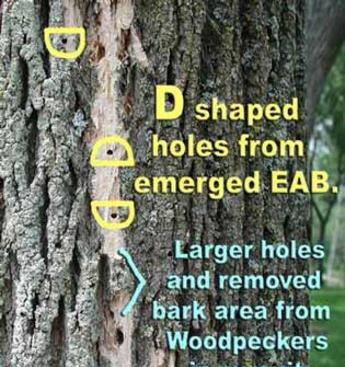
D-shaped exit holes through the bark about 1/8 inch wide.
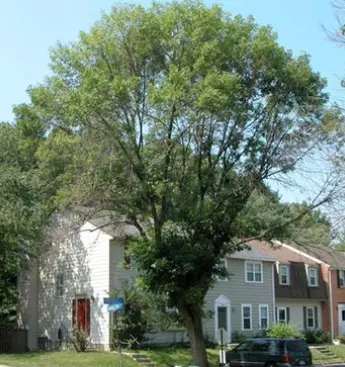
Thinning leaves or branches.
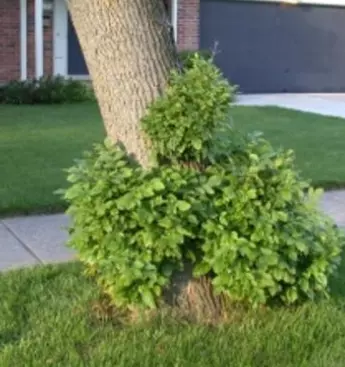
Unusual shoots sprouting from the main trunk.

Damage from woodpeckers trying to get the borer at its larvae stage.
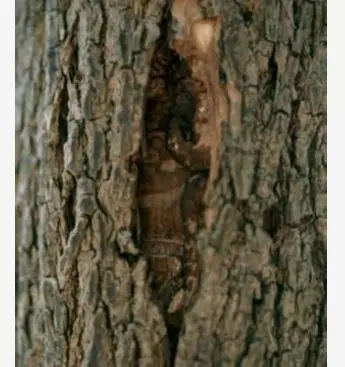
Vertical splits in the bark.

S-shaped larval galleries just beneath the bark.
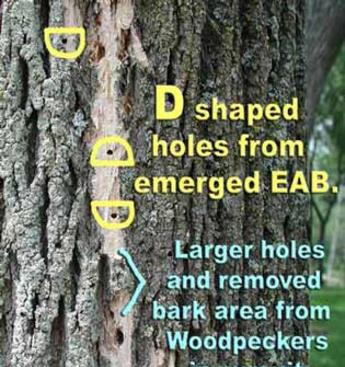
D-shaped exit holes through the bark about 1/8 inch wide.
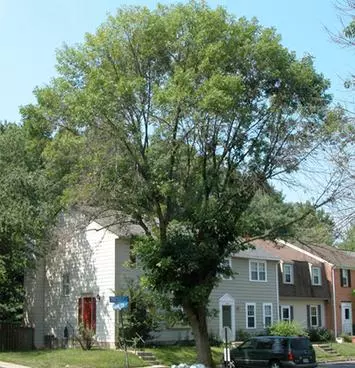
Thinning leaves or branches.

Unusual shoots sprouting from the main trunk.
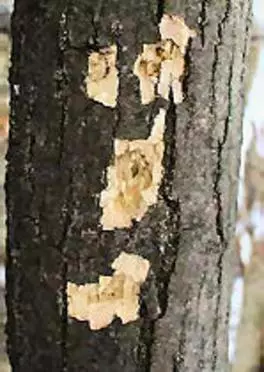
Damage from woodpeckers trying to get the borer at its larvae stage.
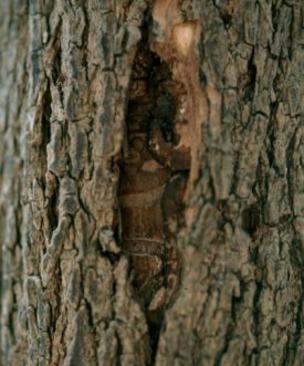
Vertical splits in the bark.

S-shaped larval galleries just beneath the bark.
Treatments
TREE-äge
TREE-äge is injected using the Arborjet Trunk Injection system. One TREE-äge application provides your ash trees with two years of control against Emerald Ash Borer. TREE-äge may only be applied by licensed pesticide applicators. The injections typically take 10–15 minutes or less.

Eco-Friendly
Unlike spraying or soil applications, Arborjet's system injects directly into the tree, limiting any impact to your family, the applicator, and the environment around you.

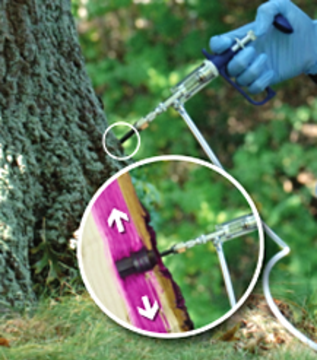
How does trunk injection work?
The tree grows right over the Arborplug.
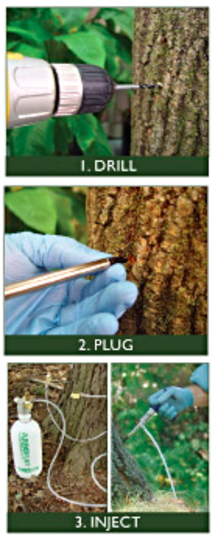
Does Drilling Hurt My Tree?
No. We all know when humans need surgery, the surgical process leads to a cure or healing, and benefits far outweigh the injury. Arborjet's Arborplug Technology minimizes the impact sealing the site from insects and inhibiting decay. The small arborplug also provides a shoulder for new xylem and bark to grow over usually in 9–12 months. For hundreds of years, there have been thousands of trees that are drilled with much larger holes for maple sugaring and others used routinely in nurseries for transporting newly sold trees.
Why Do I Need To Drill?
Formulations need to be injected into the tree's xylem (white tissue). The Xylem transports the formulation throughout the tree. Don't be fooled by cambium injections, since the cambium does not transport formulations. The cambium is also a sensitive part of the tree that is responsible for the new growth of bark and xylem tissue
More Facts About Our Trunk Injection System
Trunk injection of trees is a way to efficiently treat many different insect and disease problems, as well as nutrient deficiencies, in a manner that limits environmental exposure. This method also uses the least amount of pesticide as compared to other conventional treatment methods. Trunk injection involves using a special injection tool that places and seals the insect control directly into the trunk where it is quickly taken up by the vascular system and distributed throughout the tree.
For Emerald Ash Borer pest control: Through trunk injection, small doses of insect control are carefully measured and injected directly into the tree’s transport tissues, enabling distribution within the tree, but limiting the impact to the environment. The best time to treat Ash trees in the upper third of the country is from May through October when trees are most active, and water or nutrients are actively flowing in the tree.
The larval (damaging) stage of EAB does its worst from August through October. Injections are made in the bottom 18 inches of the tree, at intervals of around 6 inches apart. The depth for the injection is between 5/8” and 1 5/8” into the tree.
A 10-inch diameter tree would receive approximately a 1.5-ounce injection for two years of protection. Trunk injection formulations can take hours to weeks to move throughout the tree. Most often trees are protected within a few days.
Trunk injection is widely considered to be the most effective and consistent method available for preventing EAB from attacking a tree or killing EAB in an infested tree. It can stop damage even if the tree is already under attack without harming the surrounding environment.
Researchers at Michigan State, Ohio State, Purdue, the University of Illinois, and the University of Wisconsin have concluded that Arborjet’s trunk-injected systemic insecticides are the most effective treatment options, providing very effective control of EAB for two years, with a single application, even under heavy infestation pressure. It also provided a higher level of control than other products in side-by-side studies. The largest Midwestern cities, including Chicago and Milwaukee, chose and are currently using Arborjet’s trunk injection with its two years of protection, for over 115,000 boulevard trees, following careful evaluation of the alternatives.

